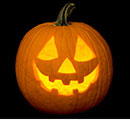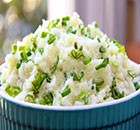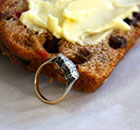The Origins of Halloween come from several different cultures. The early Celtic people of Great Britain and Northern France, the Romans, and the early Christians all had festivals that influenced the celebration of Halloween as we know it today. Halloween is a yearly celebration on 31 October.
The Roman and Christian Origins of Halloween When the Romans invaded Britain, they brought many of their customs and  festivals with them. One of these festivals, Pomona Day, took place around the end of October and honored Pomona, the Roman goddess of fruit and trees. The symbol of Pomona was the apple, which might explain the origin of our modern custom of bobbing for apples. After hundreds of years, the festivals of the Celts and the Romans combined to form one major fall holiday. With the spread of Christianity came new festivals. In the year 835, the Roman Catholic Church made a holiday on November 1st to honor all the saints. This day was called All Saints’ Day or All Hallows. Many years later, the church made November 2nd All Souls’ Day to honor the dead. People celebrated by making fires and dressing up as saints, devils, and angels. After many years, the traditions of these holidays and the holidays of the Celtic people combined and became known as Hallowed Evening, which was celebrated on October 31st, eventually, the name was shortened to Halloween.
festivals with them. One of these festivals, Pomona Day, took place around the end of October and honored Pomona, the Roman goddess of fruit and trees. The symbol of Pomona was the apple, which might explain the origin of our modern custom of bobbing for apples. After hundreds of years, the festivals of the Celts and the Romans combined to form one major fall holiday. With the spread of Christianity came new festivals. In the year 835, the Roman Catholic Church made a holiday on November 1st to honor all the saints. This day was called All Saints’ Day or All Hallows. Many years later, the church made November 2nd All Souls’ Day to honor the dead. People celebrated by making fires and dressing up as saints, devils, and angels. After many years, the traditions of these holidays and the holidays of the Celtic people combined and became known as Hallowed Evening, which was celebrated on October 31st, eventually, the name was shortened to Halloween.
The Celtic Origins of Halloween Two thousand years ago in northern Europe, the Celtic people worshipped nature and had many gods. The Celts celebrated their New Year on November 1st. This festival marked the end of their season of light and the beginning of the season of cold and darkness. On October 31st, their New Year’s Eve, they gathered together to honour one of their gods, Samhain, Samhain was the god of the dead. Samhain means “summer’s end” in Old Irish. The Celts believed that the spirits of dead people came to life and wandered around outside at this time of year. The Celtic people didn’t want to be hurt by the spirits, so they addressed in costumes to disguise themselves if they had to go outside. They also put candles in their windows to help the spirits find their way and they left offerings of food outside their homes so the spirits would treat them kindly. This might explain our modern custom of giving treats on Halloween.
the Celtic people worshipped nature and had many gods. The Celts celebrated their New Year on November 1st. This festival marked the end of their season of light and the beginning of the season of cold and darkness. On October 31st, their New Year’s Eve, they gathered together to honour one of their gods, Samhain, Samhain was the god of the dead. Samhain means “summer’s end” in Old Irish. The Celts believed that the spirits of dead people came to life and wandered around outside at this time of year. The Celtic people didn’t want to be hurt by the spirits, so they addressed in costumes to disguise themselves if they had to go outside. They also put candles in their windows to help the spirits find their way and they left offerings of food outside their homes so the spirits would treat them kindly. This might explain our modern custom of giving treats on Halloween.
The Traditions of Halloween
Carving Jack-O’-Lanterns: One of Halloween’s most popular symbols is the Jack O’ Lantern. The custom of carving jack-o’- lanterns comes from an old Irish folktale about a man named Jack. According to the story, Jack always liked to play tricks on people, and one time he played a trick on the Devil. When Jack died, he couldn’t go to Heaven because he had done many bad things in his life. He couldn’t go to Hell either because he had played a trick on the Devil. Since then, Jack has been wondering around the earth looking for a final resting place. He carries a lantern to light his way in the darkness. Jack made his lantern by putting a burning piece of coal inside a pumpkin. The colors of Halloween, orange and black, represent the colors of pumpkins and the darkness of the night. The Irish began to call his ghostly figure “Jack of the Lantern”, which became shortened over time to “Jack O’ Lantern”.
lanterns comes from an old Irish folktale about a man named Jack. According to the story, Jack always liked to play tricks on people, and one time he played a trick on the Devil. When Jack died, he couldn’t go to Heaven because he had done many bad things in his life. He couldn’t go to Hell either because he had played a trick on the Devil. Since then, Jack has been wondering around the earth looking for a final resting place. He carries a lantern to light his way in the darkness. Jack made his lantern by putting a burning piece of coal inside a pumpkin. The colors of Halloween, orange and black, represent the colors of pumpkins and the darkness of the night. The Irish began to call his ghostly figure “Jack of the Lantern”, which became shortened over time to “Jack O’ Lantern”.
Trick-or-treating : Trick-or-treating is a customary celebration for children on Halloween. Children go in costume from house to house, asking for treats such as candy or sometimes money, with the question, “Trick or treat?” The word “trick” refers to “threat” to perform mischief on the home of owners or their property if no treat is given.
Costumes: Halloween costumes originated from the Celts. They gathered around the bonfire and dressed up in elaborate animal skins and heads to disguise them as spirits because they believed that the evil spirits would be scared off by the fires.
Colcannon: The word colcannon is from the Gaelic cal ceannan, which literally means “white-headed cabbage.” Colcannon is a  traditional Irish potato dish on Halloween. It is a simple dish made with boiled potatoes, curly kale (a type of cabbage) and raw onions. Traditionally coins were wrapped in pieces of cleans paper and slipped into children’s colcannon for them to find. A coin meant you would in for a prosperous year. Sometimes people also hid ring. If you found ring, you would in for some romance. Others filled their socks with colcannon and hung them from the handle of the front door. The first man through the door would become their future husband.
traditional Irish potato dish on Halloween. It is a simple dish made with boiled potatoes, curly kale (a type of cabbage) and raw onions. Traditionally coins were wrapped in pieces of cleans paper and slipped into children’s colcannon for them to find. A coin meant you would in for a prosperous year. Sometimes people also hid ring. If you found ring, you would in for some romance. Others filled their socks with colcannon and hung them from the handle of the front door. The first man through the door would become their future husband.
The barnbrack: The barnbrack comes from the Irish Gaelic ‘bairín breac’ which literally means ‘speckled  loaf’. The barnbrack is a traditional Irish Halloween cake. It is sweet bread with fruit as well as some other treats. In traditional Ireland, each member of the family would get a slice of the delicious cake. When you chewed the treat, you had to be careful. There were several charms hidden inside wrapped in baking paper which signified the finder’s future. Ring meant you would married someone this year. Thimble meant you remained a spinster for the coming year. A coin meant you would come into wealth.
loaf’. The barnbrack is a traditional Irish Halloween cake. It is sweet bread with fruit as well as some other treats. In traditional Ireland, each member of the family would get a slice of the delicious cake. When you chewed the treat, you had to be careful. There were several charms hidden inside wrapped in baking paper which signified the finder’s future. Ring meant you would married someone this year. Thimble meant you remained a spinster for the coming year. A coin meant you would come into wealth.
Apples bobbling: The symbol of Pomona was the apple. Apple bobbing is said to have something to do with the worship of Pomona, the ancient Roman goddess of fruits, trees, and gardens in whose honour an annual festival was supposedly held every November first.
==========
 The oldest and strongest emotion of mankind is fear, and the oldest and strongest kind of fear is fear of the unknown. – H. P. Lovecraft (1890 –1937) U.S. author
The oldest and strongest emotion of mankind is fear, and the oldest and strongest kind of fear is fear of the unknown. – H. P. Lovecraft (1890 –1937) U.S. author
 Where there is no imagination there is no horror. – Sir Arthur Conan Doyle (1859 –1930) Scottish physician and writer
Where there is no imagination there is no horror. – Sir Arthur Conan Doyle (1859 –1930) Scottish physician and writer
References:
1. Pomona: http://gl.wikipedia.org/wiki/Pomona
2. Remember Your Ancestors On Samhain Night:
http://writingasilverbroomstick.wordpress.com/category/halloweensamhainallhollows-eve/
3. Why Do We Bob for Apples on Halloween?
http://urbanlegends.about.com/od/halloween/a/Bobbing-For-Apples-On-Halloween.htm
4. Halloween: http://www.esllibrary.com
5. Halloween: http://en.wikipedia.org/wiki/Halloween